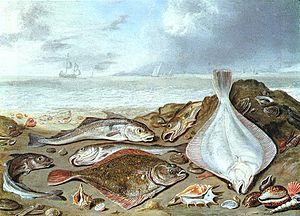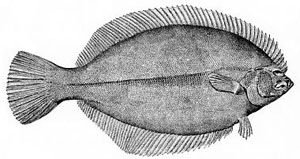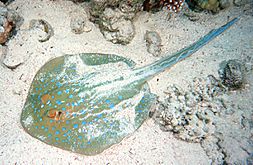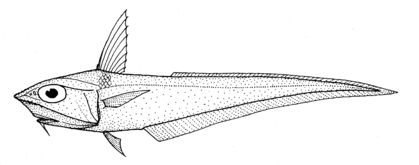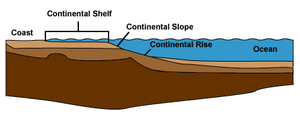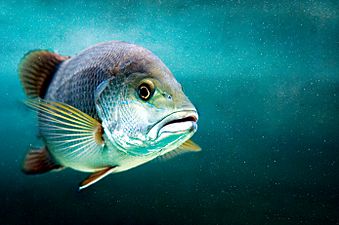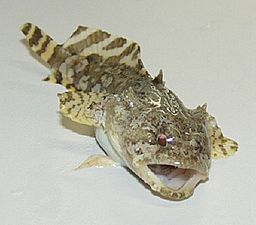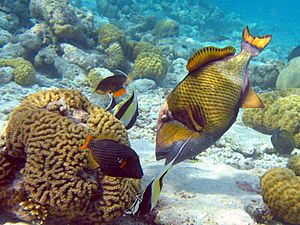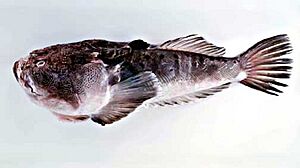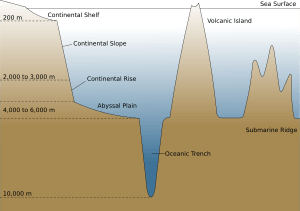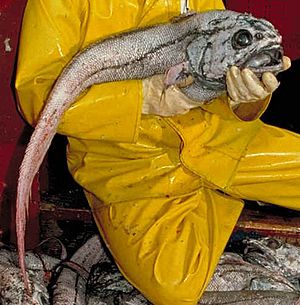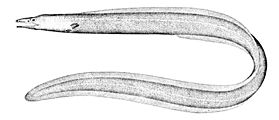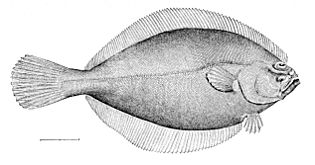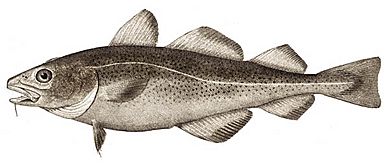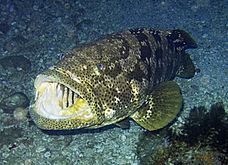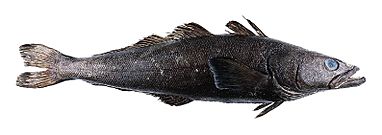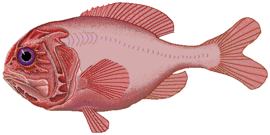Demersal fish facts for kids

Demersal fish, also called groundfish, are amazing fish that live and find their food on or very close to the bottom of oceans or lakes. This area is known as the demersal zone. They make their homes on the sea floors and lake beds, which can be made of mud, sand, gravel, or rocks. In shallow coastal waters, you'll find them near the continental shelf. In deeper parts of the ocean, they live near the continental slope or along the continental rise. The word demersal comes from the Latin word demergere, which means 'to sink'.
Demersal fish are often called bottom feeders because of where they live and eat. They are different from pelagic fish, which live and feed in the open water, far from the bottom. Demersal fish fillets have very little fish oil, usually only one to four percent. Pelagic fish, on the other hand, can have up to 30 percent oil!
Contents
Types of Demersal Fish
Demersal fish can be split into two main groups:
- Benthic fish: These fish are heavier than water and can rest directly on the sea floor.
- Benthopelagic fish: These fish can float in the water just above the sea floor.
Benthopelagic fish have neutral buoyancy. This means they can float at a certain depth without using much energy. Benthic fish are denser and have negative buoyancy, so they can lie on the bottom easily. Most demersal fish you'll find are benthopelagic.
Like other bottom feeders, demersal fish often need a way to deal with the sand or mud. They usually pump sand out of their mouths through their gill slits. Most demersal fish have a flat underside, which helps them rest on the bottom. An exception is the flatfish, which are flat from side to side but lie on their sides. Many demersal fish also have an "inferior" mouth, meaning it points downwards. This is helpful because their food is often found in the sand or mud below them. Fish with upward-pointing mouths, like stargazers, usually catch swimming prey.
Benthic Fish: Living on the Bottom
Benthic fish are heavier than water, so they can rest right on the sea floor. They might be ambush predators, waiting quietly for prey. Sometimes, they even cover themselves with sand or use other ways to camouflage themselves. Other benthic fish actively move around the bottom looking for food. Some examples of benthic fish that can bury themselves include dragonets, flatfish, and stingrays.
Flatfish are a special group of ray-finned benthic fish that lie flat on the ocean floor. Some well-known flatfish include flounder, sole, turbot, plaice, and halibut. What's really cool is that adult flatfish have both eyes on one side of their head! When they hatch, they have one eye on each side, just like most fish. But as they grow, one eye actually moves to the other side of their body. This change is called metamorphosis. After this, the flatfish changes how it lives. It camouflages itself by lying on the ocean floor with both eyes looking upwards. The side to which the eye moves depends on the type of flatfish.
-
Flounder have both eyes on one side of their head.
-
Bluespotted ribbontail rays move in groups onto shallow sands to feed.
-
The great hammerhead finds stingrays buried in the sand.
Flounder are ambush predators. They feed in soft, muddy areas of the sea bottom, near docks, reefs, and bridge piles. Their diet mostly includes fish eggs, crustaceans, worms, and small fish.
The great hammerhead shark swings its head widely over the sea floor. It does this to pick up the electrical signals from stingrays hidden in the sand. Then, it uses its "hammer" shaped head to pin the stingray down!
-
The tripodfish (Bathypterois grallator) uses its long fins to "stand" on the bottom.
-
The fringe-lipped flathead lives in estuaries.
Some fish don't quite fit into these groups. For example, the nearly blind spiderfish family is common and widespread. They eat tiny animals called zooplankton that float near the bottom. But they are still considered benthic fish because they always stay in contact with the bottom. Their fins have long rays that they use to "stand" on the bottom. They face the current and grab zooplankton as it floats by.
Benthic fish bodies are shaped to stay in contact with the sea floor. They usually have no swimbladders or very small ones. Their bodies are often flattened in some way. Here are some common body shapes for benthic fish:
| Common Body Shapes of Benthic Fish | ||
|---|---|---|
| Bottom Rovers | These fish have a body shape like a predator that roams around. Their head is often flat, their back is humped, and their pectoral fins are large. Examples include North American catfish and sturgeons. | |
| Bottom Clingers | These are usually small fish with flat heads, large pectoral fins, and special parts (often changed pelvic fins) that help them stick to the bottom. This is useful in fast rivers or areas with strong currents. Sculpins use their small fins to prevent slipping. Other fish, like gobies and clingfishes, have developed suction cups. | |
| Bottom Hiders | These fish are similar to bottom clingers but don't have clinging devices. They tend to have longer bodies and smaller heads. They often live under rocks or in cracks, or they lie quietly on the bottom in calm waters. Darters and many blennies fit this description. | |
| Flatfish | Flatfish have the most unique body shapes among bottom fish. Flounders are basically deep-bodied fish that live with one side on the bottom. One eye moves to the top side as they grow, and their mouth often twists to help them eat from the bottom. In contrast, skates and rays are flattened from top to bottom. They mostly move by flapping their very large pectoral fins. Their mouth is completely on the underside, and they breathe by taking in water through holes (called spiracles) on top of their head. | |
| Rattails | Rattail-shaped fish have large, pointy-snouted heads and big pectoral fins. Their bodies end in long, pointed tails, like a rat's tail. These fish almost always live on the deep sea bottom. We don't fully understand why this body shape is so common for them. They find food by scavenging and hunting small animals without backbones (invertebrates) that live on the bottom. Examples include grenadiers, viviparous brotulas, and chimaeras. | |
Benthopelagic Fish: Floating Above the Bottom
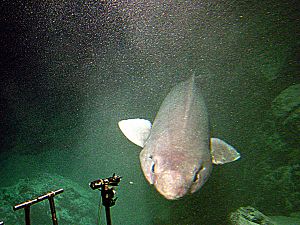
Benthopelagic fish live in the water just above the sea floor. They eat animals that live on the bottom (benthos) and tiny floating animals (zooplankton). Most demersal fish are benthopelagic.
Deep-sea benthopelagic teleosts (bony fish) all have swimbladders. The most common types, rattails and cusk eels, have a lot of body mass. Other examples include deep-sea cods, deep-sea eels, halosaurs, and notacanths.
Benthopelagic sharks, like the deep-sea squaloid sharks, float easily because they have large livers filled with oil. Sharks can handle high pressures well. They are often found on slopes down to about 2000 meters, eating dead animals that sink to the bottom, like dead whales. However, sharks need a lot of energy because they must swim constantly and keep a large amount of oil for floating. They can't get enough energy in the very poor feeding conditions found at great depths.
Shallow water stingrays are benthic; they lie on the bottom because they are heavier than water. Deep-sea stingrays are benthopelagic. Like squaloid sharks, they have very large livers that help them float easily.
Benthopelagic fish can be divided into two types: flabby or robust. Flabby benthopelagic fish are like deep-sea bathypelagic fish. They have less body mass and slow body processes. They use very little energy as they lie and wait to ambush prey. An example is the cusk-eel Acanthonus armatus. This fish has a huge head and a body that is 90 percent water. It has the largest ears and the smallest brain compared to its body size of all known vertebrates!
Deepwater benthopelagic fish are strong, muscular swimmers. They actively search the bottom for prey. They often live around places like seamounts, where there are strong currents. Good examples that are caught for food include the orange roughy and Patagonian toothfish.
Where Demersal Fish Live
The edge of the continental shelf is where the shallow shelf drops off into the deep ocean. This edge separates the shallow coastal bottom habitats from the deep bottom habitats. Coastal demersal fish live on the bottom of waters close to shore, like in bays and estuaries. They also live further out on the floor of the continental shelf. Deep-water demersal fish live beyond this edge. They are mostly found down the continental slopes and along the continental rises, which lead to the abyssal plains. This area is called the continental margin, and it makes up about 28% of the ocean floor. Other deep-sea demersal fish can also be found around seamounts and islands.
The term bathydemersal fish is sometimes used for "deep water demersal fish." Bathydemersal means demersal fish that live deeper than 200 meters.
Coastal Demersal Fish Habitats
Coastal demersal fish live on or near the seabed in coastal waters. These waters are between the shoreline and the edge of the continental shelf. Since the continental shelf is usually less than 200 meters deep, coastal waters are generally in the epipelagic zone (the sunlit surface layer). This group includes demersal reef fish and demersal fish that live in estuaries, inlets, and bays.
-
The mangrove jack eats crustaceans.
-
Many puffer fish crush the shells of molluscs.
-
Triggerfish use a jet of water to find sand dollars.
Young mangrove jacks are popular for eating and sport. They live in estuaries around mangrove roots, fallen trees, and rocky areas. These spots offer protection for smaller prey. When they grow up, they move into open waters, sometimes hundreds of kilometers from the coast, to lay their eggs.
Stargazers are found all over the world in shallow waters. They have eyes on top of their heads and a large mouth that points upwards. They bury themselves in the sand and then leap up to ambush fish and invertebrates that swim by. Some types have a worm-shaped lure growing from the bottom of their mouth, which they wiggle to attract prey. Stargazers are venomous and can even give electric shocks. Some people have called them "the meanest things in creation."
Other examples of coastal demersal fish are cod, plaice, monkfish, and sole.
Deep Water Demersal Fish Habitats
Deep-water demersal fish live in the benthic regions beyond the continental margins.
On the continental slope, demersal fish are very common. There are more different kinds of them here than in coastal waters because there are more types of habitats. Further out are the abyssal plains. These flat, plain areas cover about 40 percent of the ocean floor. They are covered with sediment but have very little life on the bottom (benthos). Deep-sea benthic fish are more likely to be found near canyons or rock formations among the plains, where communities of invertebrates live. Undersea mountains (seamounts) can block deep-sea currents, causing productive upwellings that support benthic fish. Undersea mountain ranges can also divide underwater areas into different ecosystems.
Rattails and brotulas are common deep-sea demersal fish. Other well-known families include eels, eelpouts, hagfishes, greeneyes, batfishes, and lumpfishes.
The bodies of deep-water demersal fish are muscular and have well-developed organs. In this way, they are more like mesopelagic fish than bathypelagic fish. However, they can vary a lot. They usually don't have Photophores (light-producing organs). Their eyes and swimbladders can be anywhere from completely missing to very well developed. They come in different sizes, and larger species, over one meter long, are not unusual.
Deep-sea demersal fish are usually long and thin. Many are eels or shaped like eels. This might be because long bodies have long lateral lines. Lateral lines help fish detect low-frequency sounds. Some demersal fish have muscles that make drumming sounds to attract mates. Smell is also very important, which you can see by how quickly demersal fish find traps baited with other fish.
The main food for deep-sea demersal fish is invertebrates that live on the deep-sea benthos and carrion (dead animals). Smell, touch, and lateral line senses seem to be the main ways they find their food.
Just like coastal demersal fish, deep-sea demersal fish can be divided into benthic fish (heavier than water) and benthopelagic fish (float easily).
The amount of plankton available for food quickly decreases as you go deeper. At 1,000 meters, the amount of plankton is usually only about 1 percent of what's at the surface. At 5,000 meters, it's about 0.01 percent. Since there's no sunlight, energy enters deep-water zones as organic matter. This happens in three main ways:
- Organic matter can come from land, carried by currents down rivers, along the continental shelf, and then down the continental slope.
- Other matter falls from the water above as "marine snow" (tiny bits of dead plants and animals), or as larger pieces like dead eelgrass, fish, or even whales sinking to the bottom.
- Energy can also come from fish, like mesopelagic fish that move up and down and enter the demersal zone.
The demersal fish and invertebrates eat this organic matter, break it down, and recycle it. Because of how food gets to them, the number of demersal fish and invertebrates gradually decreases the further you get from the continental shorelines.
Even though deep-water demersal fish species are not usually picky eaters, they do have some special diets. For example, different fish have different mouth sizes, which limits the size of prey they can eat. Some mostly eat benthopelagic organisms. Others mostly eat epifauna (invertebrates on top of the seafloor) or infauna (invertebrates that burrow into the seafloor). Infauna feeders can have a lot of sediment in their stomachs. Scavengers, like snubnosed eels and hagfish, also eat infauna as a secondary food source.
Some fish eat dead animals. Cameras show that when a dead fish is placed on the bottom, scavengers (both vertebrates and invertebrates) appear very quickly. If the fish is large, some scavengers burrow in and eat it from the inside out. Some fish, like grenadiers, also show up and start eating the scavenging invertebrates and amphipods. Other special diets are based on depth. Some of the more common fish species on the upper continental slope, like cutthroat eel and longfinned hake, mainly eat epipelagic fish (fish from the surface layer). But generally, the most common deep-water demersal fish species eat invertebrates.
At very great depths, a lack of food and extreme pressure make it hard for fish to survive. The deepest point of the ocean is about 11,000 meters. Bathypelagic fish are not usually found below 3,000 meters. It might be that extreme pressures stop important body processes from working correctly.
The deepest-living fish known is the strictly benthic Abyssobrotula galatheae. It's eel-like and blind, and it eats invertebrates that live on the bottom. A living example was caught from the bottom of the Puerto Rico Trench in 1970, from a depth of 8,370 meters (27,453 feet).
In 2008, a group of 17 hadal snailfish was filmed by a UK-Japan team. These deep-water snailfish were seen at depths of 7.7 km (4.8 mi) in the Japan Trench in the Pacific. The fish were 30 centimeters long (12 inches) and were darting around, using vibration sensors on their nose to catch shrimps. The team also said that the fish looked surprisingly "cute," unlike most deep-sea fish, and they were surprised by how active the fish were at such depths.
Demersal Fisheries: Fishing for Bottom Dwellers
Most demersal fish that people catch for food or sport live in coastal areas, usually within the top 200 meters of water. Important demersal food fish species include flatfish like flounder, sole, turbot, plaice, and halibut. Other important ones are cod, hake, redfish, haddock, bass, congers, sharks, rays, and chimaeras.
Black sea bass live along the US coasts from Maine to northeast Florida and the eastern Gulf of Mexico. They are most common off the waters of New York. They are found in shallow waters (bays and sounds) and offshore in waters up to 130 meters (425 feet) deep. They spend most of their time close to the sea floor. They often gather around structures like rocks, man-made reefs, shipwrecks, jetties, piers, and bridge pilings. Black sea bass are popular fish for both recreation and commercial fishing, but they have been overfished.
-
American plaice are usually found between 90 and 250 meters deep. They eat small fish and invertebrates.
-
Atlantic cod are usually found between 150 and 200 meters deep. They eat both invertebrates and fish, including young cod.
-
Grouper are ambush predators that suck their prey in from a distance.
Grouper are often found around reefs. They have strong bodies and large mouths. They are not built for swimming long distances or very fast. They can be quite large, often over a meter long and weighing up to 100 kg (220 lbs). They swallow their prey whole instead of biting off pieces. They don't have many teeth on the edges of their jaws, but they have strong crushing tooth plates inside their throat (pharynx). They wait quietly for prey instead of chasing it in open water. They live in areas with hard surfaces like ledges, rocks, and coral reefs, as well as artificial reefs like shipwrecks. Their mouth and gills create a powerful sucking system that pulls their prey in from a distance. They also use their mouth to dig into the sand to make shelters under big rocks, pushing the sand out through their gills. Their gill muscles are so strong that it's almost impossible to pull them out of their cave if they feel attacked. Some research suggests that roving coral groupers sometimes work with giant morays to hunt.
-
The Patagonian toothfish is a strong benthopelagic fish.
-
The orange roughy is also a strong benthopelagic fish.
-
The blue grenadier (hoki), a deep-water demersal fish, is part of a large sustainable fishing industry in New Zealand.
Deepwater benthopelagic fish are strong, muscular swimmers that actively search the bottom for prey. They often live around features like seamounts, where there are strong currents. Commercial examples include the orange roughy and Patagonian toothfish. These fish were once very common, and because their strong bodies are good to eat, they have been caught a lot by fishing boats.
Conservation Status: Protecting Demersal Fish
Many important demersal fish species caught in the North Sea, such as cod, plaice, monkfish, and sole, are listed by the ICES as being "outside safe biological limits." This means their populations are too low to be healthy.
- The True Sole (solea solea) is found in many places, so it's not considered a threatened species overall. However, too much fishing in Europe has caused its populations to drop severely, with fewer catches in many areas. For example, sole fishing in the western English Channel and Irish Sea could collapse, according to data in the UK Biodiversity Action Plan.
- Sole, along with other major bottom-feeding fish in the North Sea like cod, monkfish, and plaice, are listed by the ICES as "outside safe biological limits." Also, they are growing more slowly now and are rarely older than six years, even though they can live up to forty. In 2003, it was estimated that the world's populations of large predatory fish and large ground fish like sole and flounder were only about 10% of what they were before industrial fishing began. According to the World Wildlife Fund in 2006, "of the nine sole stocks, seven are overfished, and we don't know the status of the other two." There isn't enough information to check the remaining stocks. However, the amounts of fish caught for all stocks are at or near their lowest levels ever.
- In 2003, world populations of large predatory fish and large ground fish like sole and flounder were estimated to be only about 10% of what they were before industrial fishing. This is mostly because of too much fishing. Recent research suggests that the flounder population could be as low as 15 million due to heavy overfishing and pollution along the Gulf of Mexico coast of Texas.
- Seafood Watch has a list of seafood that people who care about sustainability should avoid. This list includes the following demersal fish: sturgeon (wild-caught and imported), Chilean seabass, cod (Atlantic, imported Pacific), flounder (Atlantic), halibut (Atlantic), sole (Atlantic), grouper, monkfish, orange roughy, demersal sharks, red snapper, and tilapia (farmed in Asia).
|
See also
 In Spanish: Demersal para niños
In Spanish: Demersal para niños



